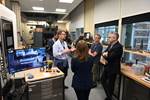Scroll to unlock this premium content if video does not play.
In laser powder bed fusion (LPBF), applying multiple materials separately within the same build seems as though it should be impossible. After all, the “bed” of the powder bed machine is an undifferentiated mass of powder, offering no capacity to segregate separate materials.
The Aerosint multimaterial system rides above the LPBF machine’s powder bed, and delivers material in place of the typical recoater mechanism.
Schaeffler Aerosint (the name reflects a recent acquisition) offers a system that brings this segregation to LPBF machines. It works by delivering different materials each to individual drums above the powder bed, with these drums using negative pressure to precisely lay material onto an in-process build. This replaces the recoater mechanism of adding uniform powder layer that is typical of LPBF.
Guha Manogharan of CIMP-3D describes the multimaterial system. All photos courtesy of Penn State University.
Penn State University’s Center for Innovative Materials Processing through Direct Digital Deposition (CIMP-3D) is experimenting with applications of this system for building parts from two or more materials within a single LPBF cycle. Guha Manogharan, recently named CIMP-3D co-director, is overseeing this research, working with 3D Systems. Valuable potential uses he sees include heat transfer components combining a thermally conductive metal and a metal for hardness or structural strength in a single solid part.
Drums use negative air pressure to precisely place various materials in a single build. Schematic of the multimaterial system courtesy of Penn State and CIMP-3D. Credit: Jacklyn Griffis, SHAPE Lab, Penn State University
Using one material to print a wall around the build is part of the process. This wall contains the powder, preventing the entire powder bed volume from having to be filled. This can bring advantages even for parts made of just one material, Manogharan notes.
He says one other potential use actually involves mono-material parts. The multimaterial system enables, and generally requires, the use of one material to form a guard wall to contain the build, because getting away from the bed-and-recoater system means the entire bed does not need to be used. This development offers valuable possibilities. It clears the way, for example, to 3D print parts from expensive materials without needing to fill the entire volume of the machine with that material.
The video above offers a brief look at the operation of the Aerosint multimaterial system.

A promising application is heat transfer components combining a thermally conductive metal and a metal for hardness or structural strength in a single solid part.
Related Content
-
Preassembled Turbojet Engine, 3D Printed in One Build: The Cool Parts Show #75
Turbojet engines typically consist of hundreds or thousands of parts, but this engine — 2023 winner of The Cool Parts Showcase for Best Proof of Concept — was 3D printed as just two pieces, with the monolithic rotor embedded inside the stationary engine shell.
-
Quadrus: Powder Management Tactics for Tungsten Rhenium and Other AM Alloys
The expert in additive manufacturing of high-value parts for the Defense Department often must change from one exotic material to another in its powder bed machines. Cleaning is a core competency. Here are lessons of this company’s system for working with an ever-changing mix of 3D printed alloys.
-
Additive Manufacturing Is Subtractive, Too: How CNC Machining Integrates With AM (Includes Video)
For Keselowski Advanced Manufacturing, succeeding with laser powder bed fusion as a production process means developing a machine shop that is responsive to, and moves at the pacing of, metal 3D printing.



















